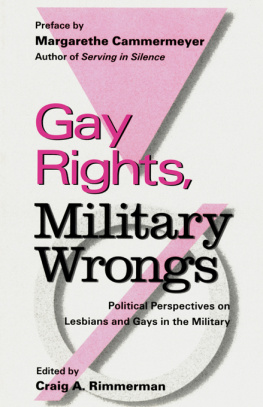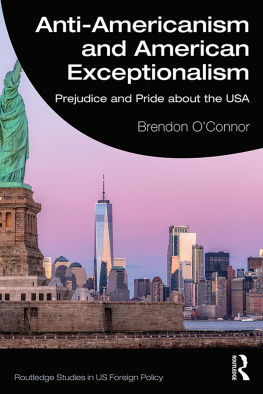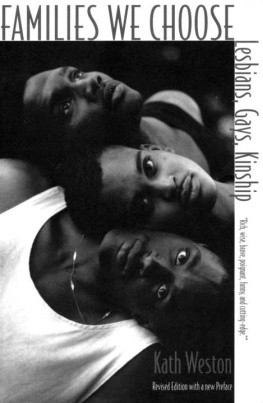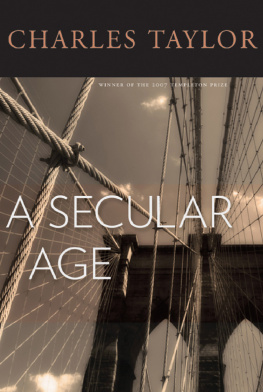YOU CAN
MAKE
A DIFFERENCE!
The nineties may well be the make-or-break decade in the fight for gay and lesbian civil rightsand this book provides a sensible battle plan for achieving equality. Grounded in well-researched fact, it will show you how to:
 | resolve internalized homophobiaand move on |
 | evaluate institutional homophobia in businesses and organizationsand do something about it |
 | influence politiciansand deconstruct harmful popular myths |
 | successfully cope with gay-related family crises, whether you are a gay son or lesbian daughteror the parent of a gay or lesbian child |
 | discuss homophobia with heterosexualscalmly and constructively |
 | come out of the closetand help others to do the same |
 | effectively fight homophobia in all walks of life. |
HOW TO MAKE THE WORLD
A BETTER PLACE
FOR GAYS AND LESBIANS
will spur you into actionand give you everything you need to fight the good fight!
Information regarding companies mentioned in this book was accurate as of January 1995.
Copyright 1995 by Una W. Fahy
All rights reserved.
Warner Books, Inc.
Hachette Book Group
237 Park Avenue
New York, NY 10017
Visit our website at www.HachetteBookGroup.com
First eBook Edition: September 2009
ISBN: 978-0-446-56485-4
Special thanks to Madeleine Morel, Joann Davis, Howard Tharsing, Barbara Lowenstein, Grace Sullivan, Terry Wolf and Mark Camin.
I grew up in a sheltered, religious environment in which everyone assumed that when children became adults they marry a member of the opposite gender and have children. No one ever discussed homosexuality. As a result, I was fifteen before I learned from a classmate that there were gay and lesbian people in the world. She said that homosexuals were awful and if I was unlucky enough to encounter one I should run. I was eighteen before I had the dreaded encounter, and the lesbian I came face to face with was myself. It was the first time I consciously understood that the reason I had no interest in boys except as friends, was fascinated by the female form, and had a serious crush on a certain young woman was because I was a lesbian. My sexual orientation felt completely natural to me.
The first person I came out to was a teacher whom I respected. She was shocked and advised me to start dating boys immediately, behave like a lady, and always wear feminine clothes. Over the next few months I experienced a major dose of reality and grew up quickly. When I came out to friends most of them distanced themselves from me and my family did not want to deal with it. The world I had known was no longer a friendly or safe place for me to be. At this point in my life I only felt comfortable and happy in the company of other gays and lesbians, and even then I would meet homosexuals who hated themselves for being gay and this disturbed me more than anything. Later, I learned that this self-hatred was one example of what is called internalized homophobia.I realized that the negative things I had heard about gays and lesbians were wrong. We were not awful people but victims of a great injustice.
At that time (the late 1970s), I became involved in the gay and lesbian rights movement. Throughout the 1970s the movement gained incredible momentum. Many gay men and lesbians felt an immense excitement about how things were beginning to change. In large numbers, gays throughout the United States were rejecting the stigma society places on homosexuality and lesbianism, coming out of the closet, attending demonstrations, challenging homophobia, and working to obtain their civil rights. The result of these efforts can be seen today. Gay and lesbian rights issues are in the forefront of the national and local political scenes. Eight states have enacted comprehensive gay rights laws, while many local municipalities ban discrimination based on sexual orientation and extend medical benefits to domestic partners of gay and lesbian municipal employees. The business community is also responding to gay and lesbian visibility. A substantial number of corporations include sexual orientation in their nondiscrimination policies and a small but growing number offer benefits for domestic partners.
While it is important to acknowledge and celebrate the achievements, we must keep in mind that we still have a long way to go and much work to do before gays and lesbians attain full civil rights. When reading How to Make the World a Better Place for Gays and Lesbiansyou will learn the battle against homophobia must be fought on many fronts. On the political front, where the focus is on civil rights legislation and laws protecting gays and lesbians from hate crimes, I encourage the use of voting power and letter-writing campaigns to influence politicians, and emphasize the need to support and become involved with gay and lesbian political organizations. In addition, I devote a section to those messengers of hate and promoters of intolerance, the religious right. The backlash orchestrated by the antigay and lesbian forces of the religious right is one of the main challenges we face. By manipulating the homophobic feelings of the majority the religious right tries to convince voters to rescind gay and lesbian rights legislation and prevent new laws from being enacted. I provide a list of the organizations that belong to the religious right and suggestions for combating their unholy crusade against gays and lesbians.
On the personal front, I stress the importance of coming out, as well as dealing with internalized homophobia. Ultimately, the battle against internalized homophobia is the most important one to win. The greatest victory for homophobia is when gays and lesbians accept the negative views put forth by a homophobic society, resulting in the destruction of their self-esteem and their preventing themselves from achieving their full potential as human beings. It is for this reason that the gay and lesbian rights movement uses the word prideas a rallying cry.
Recognizing how important it is for all citizens to have full civil rights, many heterosexuals have become involved in the gay and lesbian movement. Other heterosexuals who view this movement as someone elses battle should realize that preventing gays and lesbians from obtaining their rights is just the first item on the agenda of the religious right. Their ultimate goal is to force the government to legislating their version of morality and to dissolve the separation between church and state. If they succeedand they have had some successeveryones rights will be in danger. For this reason I recommend that heterosexuals also become involved in this struggle, and many of the actions outlined in the book can be taken by both heterosexuals and gays and lesbians.
Within these pages you will find everything you need to combat homophobia, but it is up to you to become aware, get involved, speak up, and take action. Undoubtedly, on the path to a nonhomophobic society we will encounter barriers, and in order to achieve our goal of ensuring the dignity and civil rights of gays and lesbians we must combine education with action, be optimistic, and stay proud.









